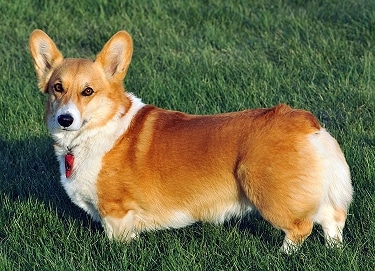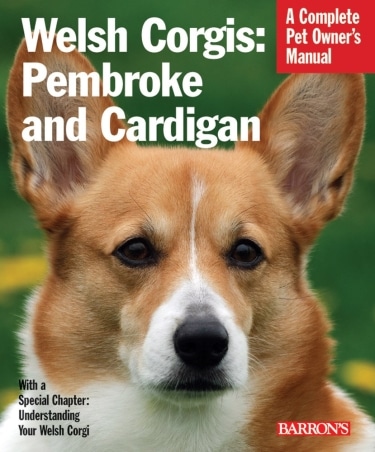
The Pembroke variety of Welsh Corgi is a cousin to the Cardigan Welsh Corgi; most likely the breed was crossed with Pomeranians, Schipperkes, or the Lancashire Heeler around the 12th Century. After that time, authorities claim that nearly every farm in Wales owned at least two Pembroke Corgis. The dogs were used mainly to herd and drive cattle. Although the Cardigan and Pembroke Corgis were originally shown as the same breed, the Pembroke Corgis tended to be more popular and won more championships. In 1934, the Pembroke and Cardigan were each recognized as a separate and official breed.
The Pembroke Welsh Corgi is affectionate and makes a wonderful family pet and companion. This breed is easy to train and gets along with other pets and animals – of course early socialization is necessary. The Pembroke Corgi enjoys country or city living, as long as he is provided with plenty of exercise.
Height: The height of a Pembroke Welsh Corgi is 10 – 12″ (25.4 – 30.5cm)
Weight: USA: Males not to exceed 30 lbs, females not to exceed 28 lbs. Canada: Males weigh 20 to 24 lbs (9-11 kg); females weigh 18 to 22 lbs (8-10 kg).
Coat Type: Pembroke Welsh Corgis have a double coat. The outer coat is dense, coarse and longer than the undercoat which is medium in length, soft and water resistant. Pembroke Welsh Corgis’ undercoat sheds twice a year. Routine brushing is necessary to keep the coat in good shape. Bathing the Pembroke Welsh Corgi should be done when necessary or about once a month.
Color: Colors of the Pembroke Welsh Corgi’s coat can include red, sable, fawn, black, or tan, with possible white markings. Regular brushing is required with no special grooming needs.
Temperament: The Pembroke Welsh Corgi is intelligent, protective and makes a great companion. They do well with children, however, the main concern is that they may nip at their heels – a behavior which should be corrected and prevented early on. The Pembroke Welsh Corgi is very alert and will bark if something is out of the norm – making him a great watch dog. These smart dogs are easy to train and respond best to firm, consistent and positive methods. Pembroke Welsh Corgis like to be with their family and with people in general, therefore best if not left alone either in the home or backyard. They also get along with other dogs and cats and as well as small animals, however, introduction must be done properly and early socialization is also a must. In addition, the Pembroke Welsh Corgi is a natural herder, so he may want to be the one in charge and herd the other pets as well as children. Exercise is very important for the Pembroke Welsh Corgi because it truly helps with physical and mental well being. Several daily long or short walks are ideal in addition to free play. Because of their short legs, exercise should not be too strenuous.
Health Concerns: The Pembroke Welsh Corgi is generally a very healthy breed. Some health issues which may be of concern include: hip dysplasia, eye problems (PRA, cataracts, retinal folds), cancer and autoimmune diseases. In addition, it is important to watch how much you feed your Pembroke Welsh Corgi as he may easily become overweight. The average life span is 12 – 15 years, although many may live well into their teens. Keeping your Pembroke Welsh Corgi active and in shape can play a significant role in its life span.
Special Interest:
• The name “Corgi” comes from the Celtic word for dog.
• In the 1930s, King George bought his daughters, Elizabeth and Margaret Rose, a pair of Corgis and their descendents are now the Royal Family’s pets.
• The Pembroke Welsh Corgi is cousin to the Cardigan Welsh Corgi and while they have many similarities, the most notable difference is their tails – the Cardigan has a tail and the Pembroke has a very short one. Another big difference is type of ear – the Pembroke Welsh Corgi has perky, upright ears while the Cardigan Welsh Corgi has rounded ears.
Classifications:
AKC: Herding Group
ANKC: Working Group
CKC: Group 7 Working Dogs
FCI: Group 1 Section 2 Sheepdogs
KC: Pastoral
NZKC: Working
UKC: Herding Dog
 Kennel.com – Complete Guide to Dogs The Dog Lovers Guide
Kennel.com – Complete Guide to Dogs The Dog Lovers Guide
